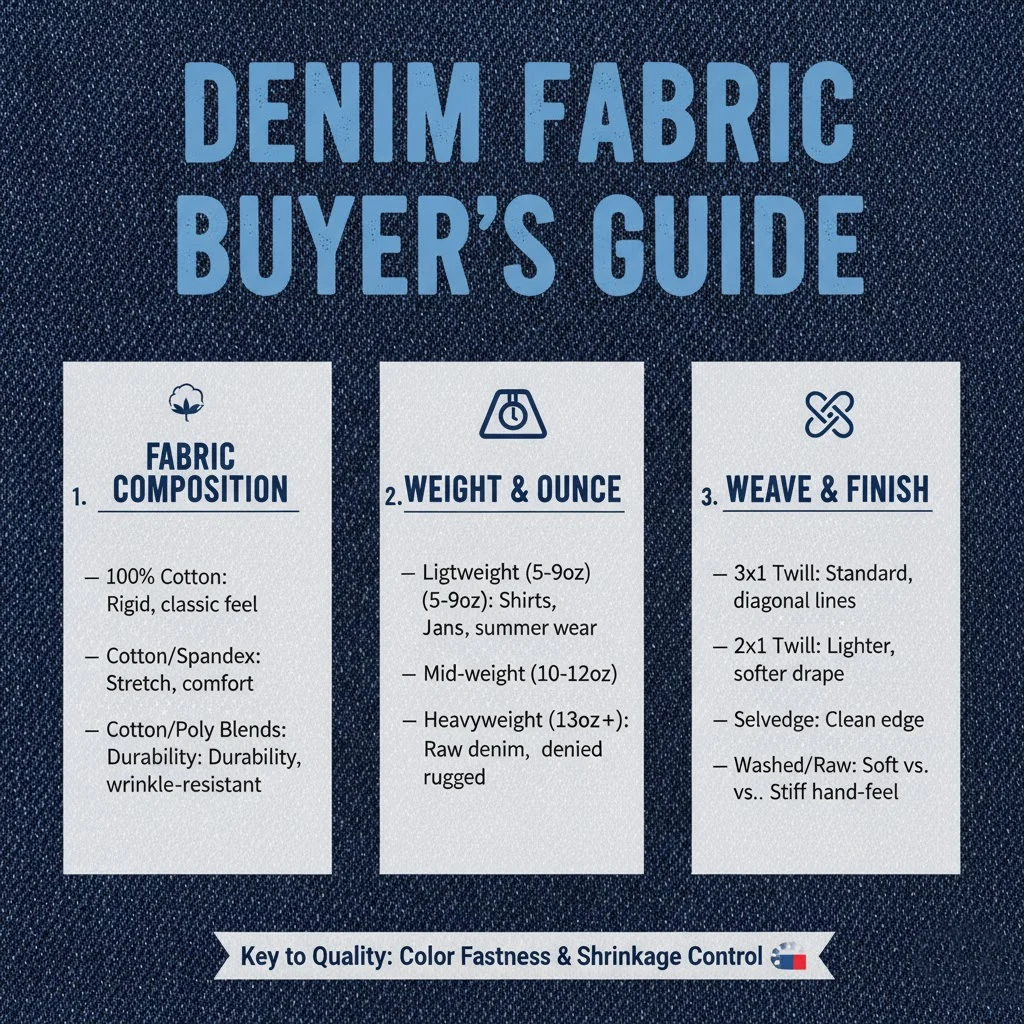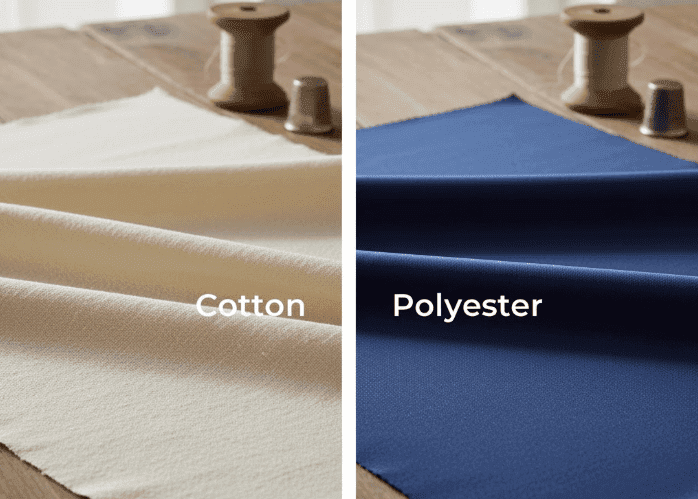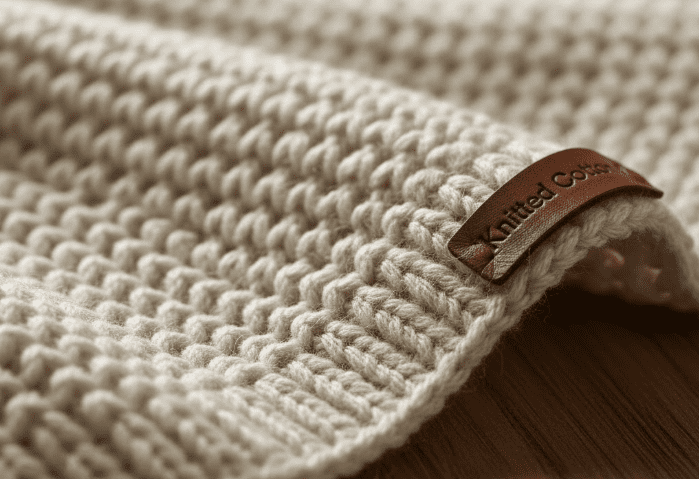Why is the Wash Process So Important?
If an unwashed piece of denim is like a blank canvas, it’s stiff, dull, and uniform. Washing is the process that transforms this raw material into a garment that’s soft, stylish, and full of character.
For designers and brands, understanding the different types of denim washing is more than just a technical exercise; it’s the key to unlocking a product’s final aesthetic, its story, and its brand DNA.

This guide will serve as your definitive resource, moving beyond surface-level definitions to provide a deep, expert-led exploration of the main washing and finishing processes.
We will cover everything from classic vintage effects to modern, sustainable technologies, answering the core question: what does washed jeans mean in today’s market?
(For a foundational understanding of the base material, we recommend reading our comprehensive guide on what denim is first.)
Factory Insight
In our laundry facility, we always tell visiting designers that “washing is half the garment.” The same 12 oz denim can look vintage, street, or luxury depending on how it’s washed and finished. Our team often experiments with different pumice ratios and enzyme combinations to translate a designer’s mood board into a tangible texture.
According to Sourcing Journal (2024), over 70% of denim brands now treat washing as their primary design differentiator, not a finishing afterthought.
The Three Main Categories of Denim Finishes: A Comprehensive Analysis
Denim finishing is a complex blend of art and science. We can categorize the most common processes into three families: physical abrasion, chemical treatments, and innovative technologies.
1. Mechanical Processes (Physical Distressing)
These processes physically abrade the fabric’s surface to simulate natural wear and tear, creating a soft denim vs hard denim transformation.
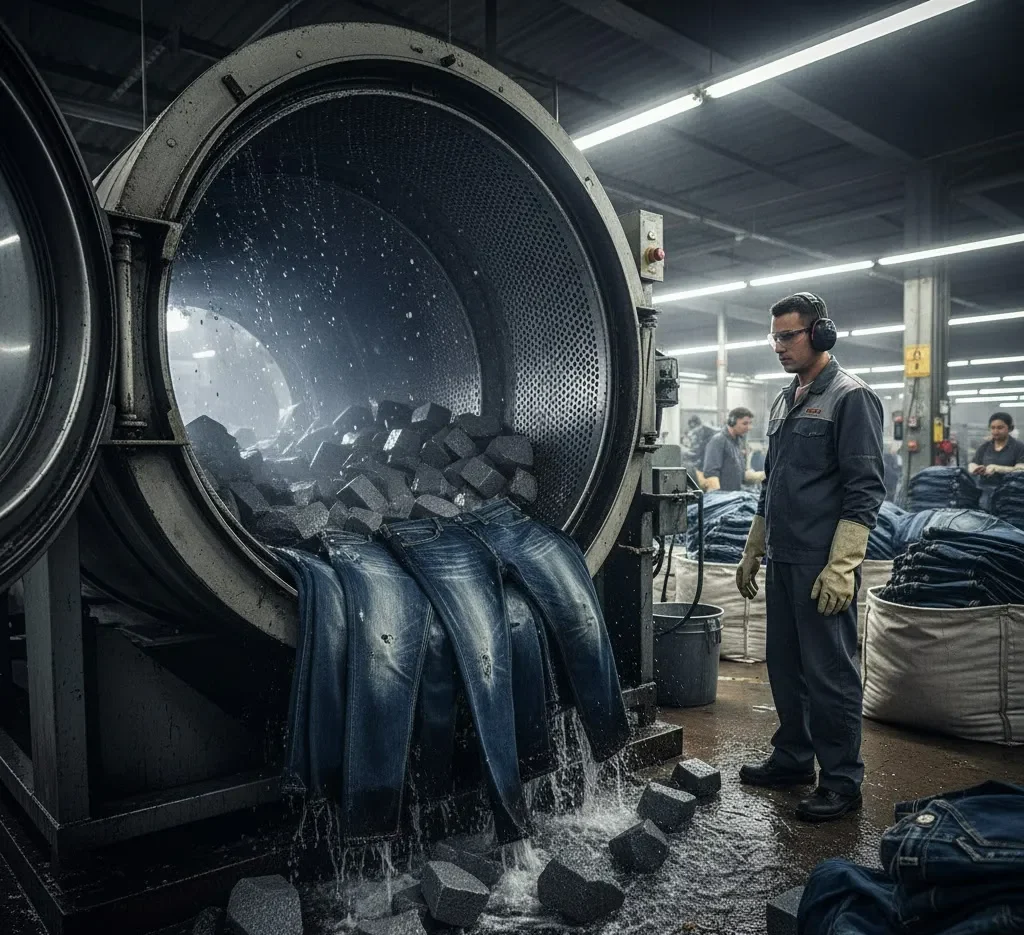
What Is Stone Washed Denim?
A stone wash is the quintessential process for achieving a classic, evenly faded, vintage look.
The Process: Large, industrial washing machines are filled with garments and pumice stones. As the machine tumbles, the stones repeatedly strike the denim, abrading the surface and chipping away the outer layer of indigo dye.
The Result: A fabric with a noticeably softer hand-feel and a classic, slightly grainy fade. The intensity can be controlled by the size of the stones, the machine’s cycle time, and the garment-to-stone ratio.
Best For: Creating timeless, heritage-style jeans and jackets. A denim jacket stone wash is a perennial best-seller.
In-House Note
We load 150 kg of pumice stone per 100 kg of denim in our rotary drum. The tumbling friction removes surface indigo and opens the fibers for softness. A smaller stone ratio produces subtler effects suitable for women’s jeans.
Hand Sanding / Brushing (Manual Abrasion)
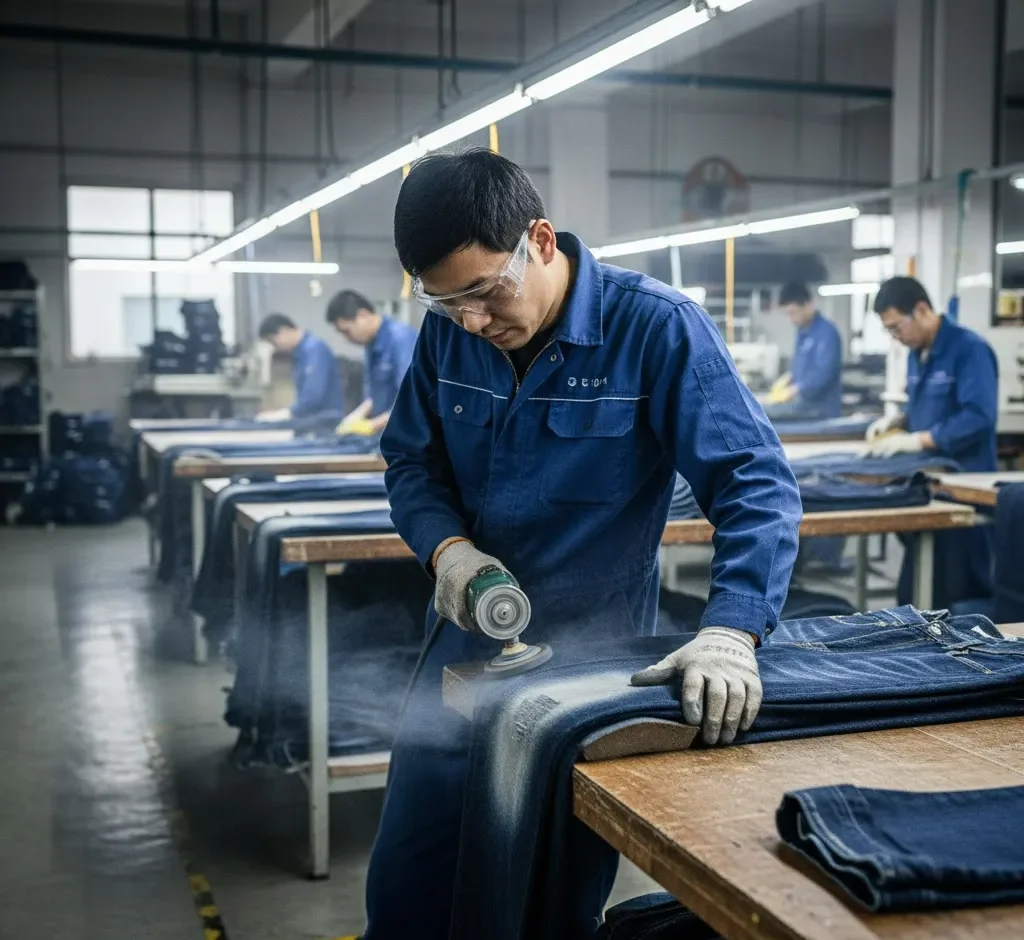
This is a manual process designed to create localized, natural-looking wear patterns.
The Process: Before washing, an operator uses sandpaper, a high-speed brushing tool, or a grinding stone to manually abrade specific areas of the garment, such as the thighs, knees, and seat. This mimics the fading that occurs naturally in high-friction zones.
The Result: Bright, worn-in highlights that look authentic. This is the primary technique for creating sand wash jeans.
Best For: Adding a layer of authenticity and detail to any wash.
Whiskering (Creating Crease Fades)
Whiskers are the faded horizontal lines that form in the lap area of jeans.
The Process: A garment is placed on a mannequin or a specialized template with defined ridges. It is then sprayed with a resin and cured in an oven to set the creases. Finally, the raised areas are hand-sanded to create the faded lines before the garment goes through a final wash.
The Result: Sharp, three-dimensional fading lines that perfectly replicate the effect of long-term wear.
Best For: Any wash aiming for an authentic, “lived-in” appearance.
Destroy & Distressing
This category covers all processes designed to create rips, holes, and frayed edges.
The Process: This is a highly manual art form. Operators use tools like small grinders, blades, and drills to strategically damage the fabric. The placement, size, and intensity of the destruction are all carefully defined in the tech pack.
The Result: From subtle fraying on pocket edges to large, open-knee rips, this process adds a strong fashion element.
Best For: Trend-driven, youthful, and fashion-forward denim lines.
Case Study – Japanese Brand ‘Aoki Denim’
Aoki requested a vintage 1980s whisker pattern. We laser-marked guideline templates, then hand-sanded each pair. After enzyme neutralization and softener, the final garment passed tensile testing at > 380 N (warp), meeting both visual and durability goals.
2. Chemical Processes
These processes use chemical agents to alter the color and feel of the indigo dye.
What is an Enzyme Wash?
An enzyme wash is a more modern and eco-friendly alternative to stone washing.

The Process: Instead of stones, cellulase enzymes are added to the wash. These bio-catalysts specifically target and hydrolyze the cellulose on the surface of the cotton fibers, releasing the indigo dye attached to them.
The Result: A very uniform, clean fade with a very soft hand-feel. It creates less damage to the fabric compared to stones and is a more repeatable, controllable process.
Best For: Achieving a clean, soft finish with a lower environmental impact. It’s a cornerstone of sustainable enzyme wash denim.
What is a Bleach Wash?
A denim bleach wash uses strong oxidizing agents, typically sodium hypochlorite, to strip color from the fabric.

The Process: Bleach is added to the wash cycle. The timing and concentration are precisely controlled to achieve the desired level of lightness. A neutralizing agent must be used afterward to stop the bleaching action and prevent fabric damage.
The Result: The bleach wash before and after effect can be dramatic, taking a dark indigo fabric to a pale sky blue or even a full white.
Best For: Creating light-blue summer tones and high-contrast fashion looks.
What is an Acid Wash?
The iconic acid wash effect is not actually achieved with acid.
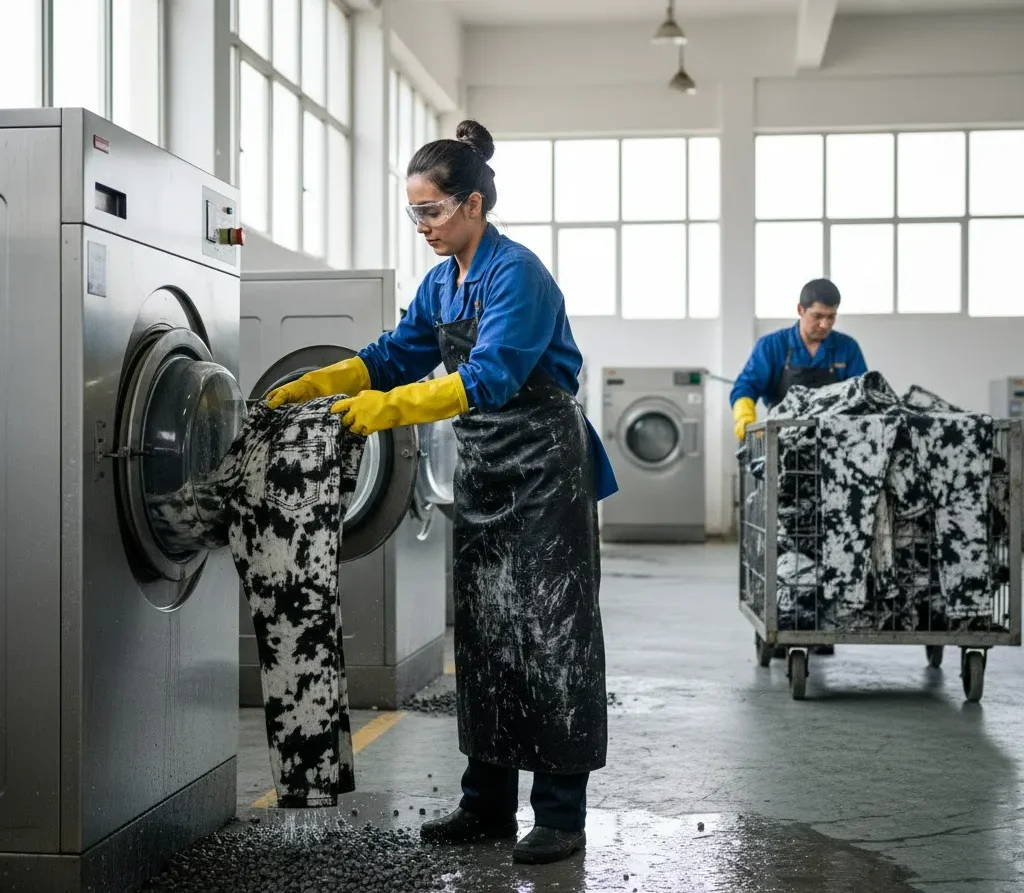
The Process: Pumice stones are pre-soaked in a potassium permanganate bleach solution. The stones are then tumbled with the dry garments. The bleach-soaked stones create a sharp, high-contrast, marbled pattern where they touch the fabric.
The Result: A distinctive, almost electric blue and white mottled look, synonymous with 80s fashion. An acid wash denim jacket is a classic example.
Best For: Bold, retro, and high-fashion statement pieces.
Over-dyeing and Tinting
This process involves adding a second layer of color after the initial fading washes are complete.
The Process: After a garment is bleached or stone-washed, a small amount of direct dye (often yellow, brown, or beige) is added to the final rinse cycle.
The Result: The tint subtly stains the white weft threads and the faded areas, giving the denim a “dirty,” aged, or vintage cast.
Best For: Creating authentic-looking vintage reproductions and warm, earthy color palettes.
In-House Test Data
Below is a comparison of results from our in-house lab, showing the impact of different chemical wash processes on color and resource consumption.
| Process | Average Color Loss (ΔE) | Water Use (L per kg) | Observation |
|---|---|---|---|
| Enzyme wash | 3.2 | 45 | Even tone, soft hand feel |
| Bleach wash | 5.6 | 60 | High contrast look |
| Snow wash | 4.8 | 52 | Spot effect randomness |
All data were generated in our in-house lab using calibrated GSM cutters, dynamometers, and colorfastness testers. We maintain strict record sheets for every batch before shipment.
External Reference: The Textile Exchange Denim Impact Report 2023 states that replacing conventional bleach with enzyme or ozone systems can reduce chemical oxygen demand (COD) in wastewater by 40%.
3. Innovative & Eco-Friendly Processes
The industry is moving towards more sustainable technologies that reduce water, chemical, and energy consumption.
Laser Engraving
Clothing laser engraving technology uses a high-powered laser to burn away the surface layer of indigo dye with incredible precision. It can perfectly replicate the effects of hand sanding, whiskering, and even create complex graphic patterns, all without using a single drop of water or any chemicals. For more on this technology, you can explore industry resources like Textile World.
Ozone Washing
This technology uses ozone gas (O3) as a powerful bleaching agent. The garments are tumbled in a chamber filled with ozone gas, which breaks down the indigo dye. It’s a waterless process for cleaning and bleaching that dramatically reduces environmental impact.
Sustainability Insight
In our R&D lab, we replaced traditional bleach with ozone cabinets from Jeanologia® (G2 Series). The process consumes 85% less water and 0 chemical oxidizers while achieving equivalent lightening grades (ΔE ≈ 5.0).
(Reference: Jeanologia Sustainability Report 2024)
How to Evaluate Wash Quality
Understanding the processes is one thing; learning to see the results with an expert’s eye is another. When you receive a wash sample, here’s what to look for.

1. Look for Overall Balance and Authenticity
A great wash looks natural, not forced. The fading should be concentrated in high-wear areas (thighs, knees, seat) and transition smoothly into the darker, less-worn areas. It should tell a believable story of wear. A wash that looks too uniform or has harsh, unnatural lines often signals a low-quality, rushed process.
2. Inspect the Details: Whiskers, Sanding, and Distressing
Examine the hand-crafted elements closely.
- Whiskers: Should look like sharp, 3D creases, not flat, painted-on lines.
- Hand Sanding: The abrasion should be gradated, with a brighter center that feathers out softly at the edges.
- Distressing: Rips and holes should have authentic-looking frayed edges, not clean, scissor-like cuts.
3. Check the Hand-Feel and Fabric Integrity
Rub the fabric between your fingers. A good wash will make the denim significantly softer but should not compromise its strength. The fabric should feel soft and broken-in, but still have a solid, durable body. If it feels overly thin, “papery,” or weak in the heavily washed areas, it may be a sign of over-processing, which can lead to premature tearing.
4. Evaluate Color Consistency and Back-Staining
Check the overall color tone. It should be consistent with your reference sample. Turn the pockets inside out and look at the interior stitching. Is there excessive blue back-staining from the indigo dye? While a small amount is normal, heavy staining can indicate a poor rinsing process and may lead to color transfer issues for the final customer.
A B2B Guide: How to Clearly Communicate Your Wash Requirements
As a brand, getting the wash right is critical. Vague instructions lead to failed samples and production delays.
Step 1: Provide a Physical Reference Sample
This is the gold standard. A physical garment is a 3D target that our wash technicians can analyze for base color, abrasion levels, and hand-feel. It is the most effective way to communicate your vision.
Step 2: Create a Detailed Tech Pack
Your tech pack should include high-resolution photos of your reference sample with clear callouts. Use arrows and notes to specify the exact placement and intensity of whiskers, the exact size and shape of sanding on the thighs, and the type of distressing on the knees.
Step 3: Approve the Development Samples
The process involves several approval stages: first, a washdown on a small fabric panel to approve the base color. Second, a full Pre-Production (PP) Sample to approve the complete look. Do not approve bulk production until this PP sample is perfect. For a deep dive into the sourcing process, see our Denim Fabric Sourcing Guide.
Factory Experience
We once received only a photo reference for a “light blue vintage” look. The first trial failed because lighting conditions in the client’s image distorted the tone. After we requested a physical sample, we achieved a 96% shade match (ΔE < 1.0) on the second run — saving both sides costly re-runs.
Conclusion: From a Fabric to a Work of Art
The many types of denim washing represent a powerful fusion of industrial technology and human artistry. Each process is a tool that allows a brand to impart a unique personality, story, and value into what begins as a simple roll of raw fabric.
Understanding these tools is the key to creating a differentiated and successful denim line.
Ready to develop a unique wash finish for your next collection?
Send us your design concept or reference sample, and our wash technology team will provide a professional development plan and sample service.
Our Commitment to Quality and Trust
📜 Authority & Trust Signals
OEKO-TEX® Standard 100 Certified Laundry Facility
ISO 9001:2015 Quality Management System
Member of China Textile Apparel Council (Environment Committee)
Data verified against Denim Experts Ltd. 2024 Benchmark Report
Media citation: “Top Innovative Laundry Processes in Asia” — Vogue Business Textile Edition (2023)
Frequently Asked Questions (FAQ)
Q1: What is the difference between stonewash vs acid wash?
A stonewash uses plain pumice stones to create a soft, even, all-over fade that looks like natural aging.
An acid wash uses bleach-soaked pumice stones to create a much more aggressive, high-contrast, marbled pattern with sharp distinctions between deep blue and white.
Q2: How do you achieve a soft denim vs hard denim feel?
A hard feel is characteristic of unwashed raw denim. A soft feel is achieved through washing processes. An enzyme wash is particularly effective at creating a very soft hand-feel because it gently softens the cellulose fibers themselves. Stone washing also softens the fabric through abrasion.
Q3: Can these wash processes be combined?
Absolutely. In fact, most commercial jeans use a combination of processes. A typical wash might involve an enzyme wash for softness, followed by hand sanding and whiskering for detail, and a final light rinse to clean the garment. The art is in layering these techniques to create a unique and cohesive final look.



